Mindful Coloring for Students: Bringing Calm and Focus to the Classroom
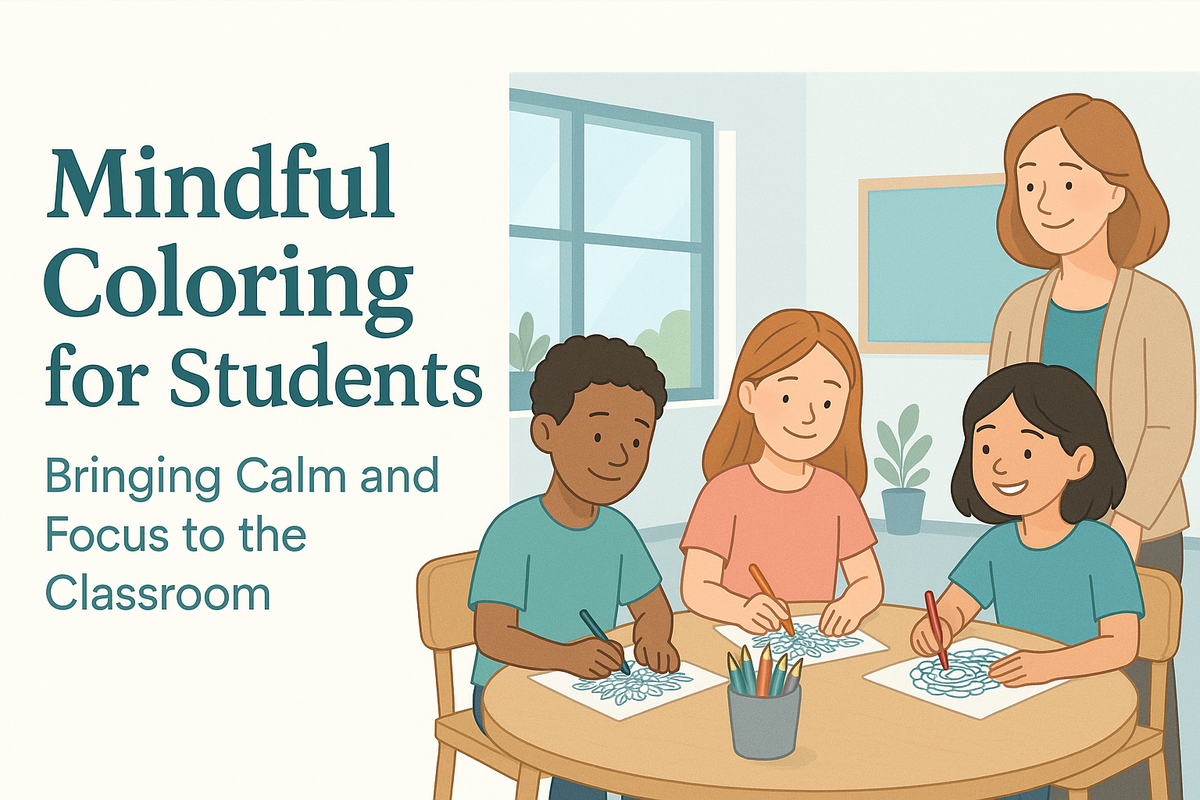
Teaching can be a rewarding but sometimes overwhelming job. With busy schedules, noisy classrooms, and constant demands, it is easy to feel stressed; both for teachers and students. That is where mindful coloring comes in.
Mindful coloring is a simple activity that encourages calmness, focus, and emotional balance. It is not just for students; it can be a powerful tool for teachers to create a peaceful classroom environment and help students manage their feelings. In this blog, we will explore what mindful coloring is, how it helps, and how you can easily use it in your classroom to support both learning and well-being.
What is Mindful Coloring?
Mindful coloring is the practice of focusing your attention on the act of coloring while being present in the moment. It is a form of mindfulness - a technique that helps individuals slow down, become more aware of their thoughts and feelings, and reduce stress. Unlike regular coloring, mindful coloring encourages a calm and thoughtful approach, where the goal is not to finish quickly or stay within the lines, but rather to enjoy the process itself.
For students, mindful coloring offers a quiet time to breathe, reflect, and settle their emotions. For teachers, it can be an effective classroom tool to promote mental well-being and create a more focused and peaceful learning environment.
How it Works:
Mindful coloring involves:
- Choosing a coloring page or pattern (like mandalas, nature scenes, or abstract shapes)
- Selecting colors intentionally
- Paying close attention to how the pencil or crayon feels on the paper
- Noticing your breathing, thoughts, and sensations as you color
- Letting go of judgment or the need for perfection
The idea is to be fully engaged at the moment, using coloring as a way to disconnect from distractions and reconnect with inner calm.
Why it is Different from Regular Coloring:
While any coloring activity can be relaxing, mindful coloring is intentional. It does not require artistic skill or creativity. Instead, it emphasizes being present, taking your time, and observing your inner experience. That is what makes it a valuable mindfulness practice, not just an art project.
Why Mindful Coloring Works in the Classroom
Classrooms are often filled with noise, movement, and energy, which can be exciting but also overwhelming. Students may come in with different emotions, attention levels, or stress from outside the classroom. As a teacher, creating a calm and focused environment can sometimes feel challenging. This is where mindful coloring can make a real difference.
Mindful coloring offers a simple yet powerful way to bring stillness and focus into the classroom, benefiting both students and teachers. It is easy to implement, does not require expensive materials, and can be used with students of all ages.
Promotes Calm and Reduces Stress
Mindful coloring helps students slow down and focus on the present moment. The repetitive motion of coloring can have a calming effect on the nervous system, much like meditation. It gives students a break from overstimulation and helps them manage feelings of anxiety, frustration, or restlessness - making it especially useful after recess, before tests, or during transitions.
Improves Focus and Attention
When students are asked to focus on coloring slowly and thoughtfully, they learn to pay closer attention to details. This trains the brain to concentrate, which can improve overall attention span in the classroom. It is a great way to help students “reset” their minds before starting academic tasks.
Encourages Emotional Awareness
Mindful coloring gives students a quiet space to tune into their thoughts and feelings without needing to express them out loud. This can be especially helpful for students who struggle with emotional regulation or communication. Over time, students become more aware of their emotions and learn to process them in healthy ways.
Supports Classroom Management
Incorporating mindful coloring into your routine can make your classroom feel more peaceful. Students who feel calm and centered are less likely to act out or become disruptive. It can be a great strategy to use as a warm-up in the morning, a cool-down after active play, or a quiet-time activity for early finishers.
Inclusive and Accessible for All Students
One of the best things about mindful coloring is that it does not require any special skills. Every student, regardless of age, ability, or background, can participate. It provides a level playing field where students can engage without the pressure of grades or performance.
Creates a Positive Classroom Culture
When students practice mindfulness together, even through something as simple as coloring - it fosters a shared sense of calm and respect. It can become a class tradition or ritual that students look forward to, helping build a sense of community and emotional safety.
Benefits of Mindful Coloring for Students and Teachers
Mindful coloring is more than just a creative activity; it is a meaningful practice that can positively impact both students and teachers. Whether used as a daily routine, a brain break, or a calming transition between lessons, mindful coloring offers emotional, cognitive, and behavioral benefits for everyone involved in the classroom.
Benefits for Students
Enhances Emotional Regulation: Mindful coloring helps students identify and manage their emotions. When they focus on coloring, they have time to process how they are feeling. This quiet, calming activity allows them to reset emotionally and return to learning with a more balanced mindset.
Improves Concentration and Patience: By slowing down and paying attention to details, students build patience and develop stronger concentration skills. These are essential for learning and can help improve focus in other classroom tasks like reading, writing, and problem-solving.
Reduces Anxiety and Stress: Coloring mindfully offers a safe outlet for stress. The repetitive motion, paired with deep focus, relaxes the brain and reduces anxious thoughts. It is especially helpful for students who may be dealing with test anxiety, overstimulation, or challenging situations outside of school.
Boosts Confidence and Independence: There is no right or wrong way to do mindful coloring, which makes it an encouraging activity for all students. It helps them feel successful and confident, even if they typically struggle with academic tasks.
Encourages Creativity and Self-Expression: Although mindful coloring focuses on being present, it still invites creativity. Students can choose colors that reflect their mood or personality, giving them a chance to express themselves non-verbally.
Benefits for Teachers
Provides a Calm Start or Reset: Mindful coloring can be used as one of the classroom management strategies to transition between activities or start the day on a peaceful note. It helps set a tone of calm and focus, making it easier for teachers to guide students through the day.
Supports Classroom Harmony: When students are emotionally settled and engaged, the classroom runs more smoothly. Teachers experience fewer disruptions and spend less time managing behavior, allowing more time for actual teaching.
Reduces Teacher Stress: Teachers face pressure daily, and introducing mindful practices like coloring benefits not just students, but teachers too. Even a few quiet minutes of shared coloring can create a sense of peace and lower stress levels in the classroom environment.
Encourages Mindful Teaching: When teachers practice mindfulness with students, it helps reinforce a teaching style that is more present, patient, and emotionally aware. This can lead to better connections with students and a more positive classroom culture.
Easy to Implement and Low-Cost: Mindful coloring does not require fancy equipment or long prep times. It is a low-effort, high-impact activity that can be used with any age group and adapted to fit into different parts of the school day.
How to Introduce Mindful Coloring in Your Classroom
Introducing mindful coloring in your classroom does not require a major shift in your routine or curriculum. With a bit of planning and the right approach, it can become a simple, effective tool to support emotional well-being and concentration among your students. Here is how you can get started:
Explain the Purpose to Your Students
Start by helping students understand what mindful coloring is and why you are introducing it. Keep your explanation age-appropriate. For younger students, you can say something like,
“This is a quiet time where we relax and color slowly, paying attention to what we are doing.”
For older students, you might explain that it is a way to calm the mind, reduce stress, and improve focus. Let them know it is not about making perfect art - it is about enjoying the process and being present in the moment.
Choose the Right Materials
Select coloring pages that are simple, calming, and appropriate for the age group. Mandalas, nature patterns, or abstract designs work well. You can find many free mindful coloring sheets online, or use coloring books designed for mindfulness.
Keep coloring supplies such as crayons, colored pencils, or markers organized and easily accessible. You do not need fancy materials; just ensure they are safe, clean, and plentiful.
Set the Right Atmosphere
Creating a calm environment helps students engage more deeply in the practice. Here are a few ideas:
- Play soft, instrumental music in the background
- Dim the lights slightly or close the blinds
- Encourage silence or soft voices during the activity
- Ask students to sit comfortably and take a few deep breaths before starting
By setting a peaceful tone, you make the activity feel different and more intentional than regular free-time coloring.
Provide Gentle Guidance
In the beginning, guide students through the process. You might say:
- Take your time and color slowly.
- Notice how it feels to color each section.
- Try not to worry about making it perfect.
- If your mind wanders, that is okay, just bring your focus back to the coloring.
This helps students understand that mindful coloring is about awareness, not achievement.
Start Small and Be Consistent
You do not need to dedicate a large block of time to start seeing the benefits. Begin with short 5-10 minute sessions once or twice a week. Over time, you can increase the duration or frequency based on how students respond.
Consider integrating it into:
- Morning routines
- After recess or lunch
- Transitions between lessons
- End-of-day reflections
- Calming corners or sensory breaks
Reflect After the Activity
Once students are finished, take a minute or two to reflect as a group. Ask gentle questions like:
- How did that feel?
- Did anyone notice anything new while they were coloring?
- How do you feel now compared to before we started?
Reflection reinforces the idea that mindful coloring is more than just a task; it is a tool for self-awareness and emotional care.
Adapt for Different Needs and Age Groups
Mindful coloring is flexible. For younger students, offer larger designs with fewer details. For older students, provide more intricate patterns or allow them to create their own designs. You can even tie coloring into lessons, such as coloring historical scenes in social studies or patterns in math.
Additionally, be mindful of students who may not enjoy coloring. Offer alternatives like doodling, tracing, or using mindful drawing prompts so every student can participate in a way that works for them.
Mindful Coloring Activities and Ideas
Mindful coloring can easily be woven into your classroom routine with creative and engaging activities. Whether you are working with early learners or older students, there are a variety of ways to introduce mindful coloring to support focus, relaxation, and emotional regulation. Below are a range of activity ideas categorized by age group and classroom goals.
1. Morning Mindfulness Coloring Routine
Best for: All age groups
Start the day on a calm and positive note by giving students a few minutes to color quietly as they arrive. Use calming background music to create a peaceful atmosphere. This helps students ease into the school day, especially those who may feel anxious or overwhelmed in the mornings.
Tip: Keep a “Morning Calm Basket” with printed coloring pages and colored pencils near the classroom entrance for easy access.
2. Emotions Mandalas
Best for: Ages 6+
Give students mandalas with prompts tied to emotions. For example, “Choose colors that represent how you are feeling right now.” This activity encourages self-awareness and reflection while reinforcing the connection between color and emotion.
Extension: After coloring, allow students to journal or share (if comfortable) how the colors they chose relate to their mood.
3. Subject-Based Coloring Pages
Best for: Ages 7+
Incorporate mindful coloring into lesson content. Create or use themed pages related to current subjects, such as symmetry in math, animal habitats in science, or cultural patterns in social studies. Encourage students to color slowly and intentionally while thinking about what they have learned.
Example: After a lesson on the rainforest, students can color rainforest animals or plant patterns while listening to calming rainforest sounds.
4. “Color Your Breath” Activity
Best for: Ages 5–10
This simple activity combines breathing with coloring. Give students a pattern or shape and ask them to color one section each time they take a deep breath. This helps build a connection between breathwork and mindfulness in a hands-on way.
Prompt: “Inhale slowly…now color one part of the shape. Exhale...now color another.”
5. Partner or Group Coloring
Best for: Ages 8+
Give a larger coloring sheet or poster to pairs or small groups. Encourage them to work together quietly and respectfully, taking turns and staying focused. This promotes teamwork and mindful collaboration. This can also be used as one of the fun team-building activities.
Guidelines: Remind students to be present, avoid rushing, and respect each other’s coloring styles.
6. Coloring During Transitions
Best for: All age groups
Use mindful coloring as a transition activity between high-energy or intense lessons. It serves as a mental “reset” to help students refocus.
Example: After a noisy group activity, let students return to their seats and color for 5-10 minutes before starting the next task.
7. Gratitude Coloring Pages
Best for: Ages 6+
Offer coloring sheets with gratitude-themed prompts such as:
- Color this heart and think of someone you are thankful for.
- Color each leaf while naming something that makes you happy.
This activity promotes positive thinking and helps students focus on the good around them.
8. Free Choice Mindful Coloring Time
Best for: All age groups
Allow students to choose from a selection of mindful coloring sheets and use the time however they need. Some may focus quietly on coloring, while others may reflect, breathe deeply, or even pair it with calming music.
Purpose: Empower students to take ownership of their mindfulness practice in a way that suits their needs.
Tips for Making Mindful Coloring a Regular Practice
While introducing mindful coloring is a great first step, the true benefits come when it becomes a regular and intentional part of your classroom culture. When students know they can depend on this time to reset, reflect, or refocus, mindful coloring turns into a powerful tool for mental well-being and classroom management. Here is how you can make it a consistent practice:
Schedule it Into Your Weekly Routine
Consistency helps students form habits. Set specific days or times when mindful coloring will happen, such as every Monday morning, Wednesday after lunch, or Friday before dismissal.
A predictable schedule creates a sense of security and something for students to look forward to. It also helps build structure into your classroom’s emotional wellness routine.
Keep Materials Ready and Accessible
Prepare a dedicated “Mindfulness Corner” or supply box that includes:
- A variety of coloring pages (mandalas, nature patterns, shapes, seasonal themes)
- Crayons, colored pencils, and markers
- Clipboards or trays for working anywhere in the room
Organize materials by age or difficulty level so students can easily find what suits them best.
Encourage Participation Without Pressure
Make mindful that coloring is a choice, not a chore. Encourage students to participate, but never force them. The goal is to create a safe, judgment-free space.
Alternative idea: Offer doodling or simple drawing as an option for students who do not enjoy coloring. The goal is mindfulness, not perfection or staying within the lines.
Create a Calming Environment
Help set the tone each time with simple techniques like:
- Soft background music or nature sounds
- Dimmed lights or natural light
- A few minutes of deep breathing before beginning
- Asking students to stay quiet or speak softly while coloring
A peaceful environment signals to students that this time is special, reflective, and restorative.
Link Coloring to Emotions and Self-awareness
Help students connect coloring to their emotional state. Before starting, invite them to reflect on a question such as: How am I feeling right now?, What color matches my mood today? This builds emotional intelligence and helps students express feelings nonverbally.
Celebrate Without Comparing
Avoid turning mindful coloring into a competition. Instead of praising “pretty” coloring, highlight things like: Patience, Creativity, Focus, and calmness. You can occasionally create a class gallery or bulletin board with student artwork if they are comfortable sharing.
Adapt to Different Ages and Needs
Mindful coloring can work at every grade level, just tweak your approach:
Younger students: Use larger shapes and fewer details
Older students: Offer intricate patterns or incorporate reflection prompts
Students with special needs: Provide textured tools or allow breaks as needed
Being flexible ensures that everyone can benefit in a way that works for them.
Model Mindfulness Yourself
When possible, sit and color alongside your students. Your calm presence can reinforce the value of the activity and set an example of what mindful behavior looks like.
Students often mimic teacher behavior. When they see you engaged and present, they are more likely to take the practice seriously.
Reflect Regularly
After a few sessions, talk with your students about how the activity helps them. You can ask: What do you like about this time? Do you feel different before and after coloring?, or Should we keep doing this every week?”
Involving them in the process increases their investment and gives you helpful feedback to make it even more effective.
What Makes a Worksheet "Mindful"?
Not all coloring pages are created equal. Mindful coloring worksheets are thoughtfully designed to:
- Include repetitive, calming patterns like mandalas, nature shapes, or geometric designs
- Avoid overstimulating images or busy scene
- Offer prompts or quotes that encourage reflection and mindfulness
- Leave room for creative freedom without overwhelming students
Some worksheets also include short journaling prompts or breathing cues to deepen the mindfulness practice.
Top 6 Mindful Coloring Worksheets to Use
Here are some popular styles you can include in your classroom:
1. Mandalas: Circular, repetitive patterns that encourage calm and concentration
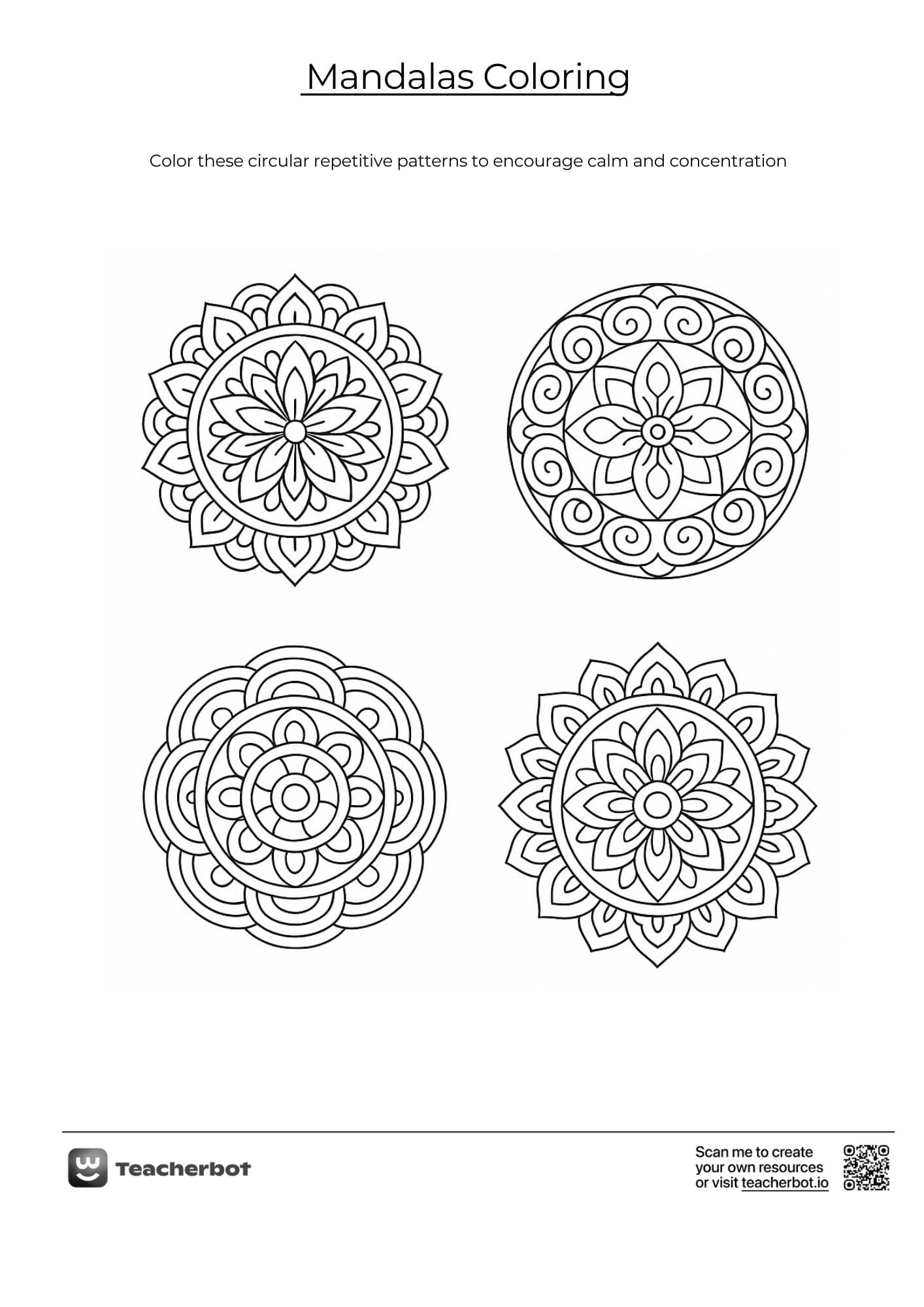
2. Nature-Themed Pages: Trees, leaves, clouds, or animals to connect students with nature

3. Emotion-Based Designs: Sheets with prompts like “Color how you feel today” or “Use a color for each mood”
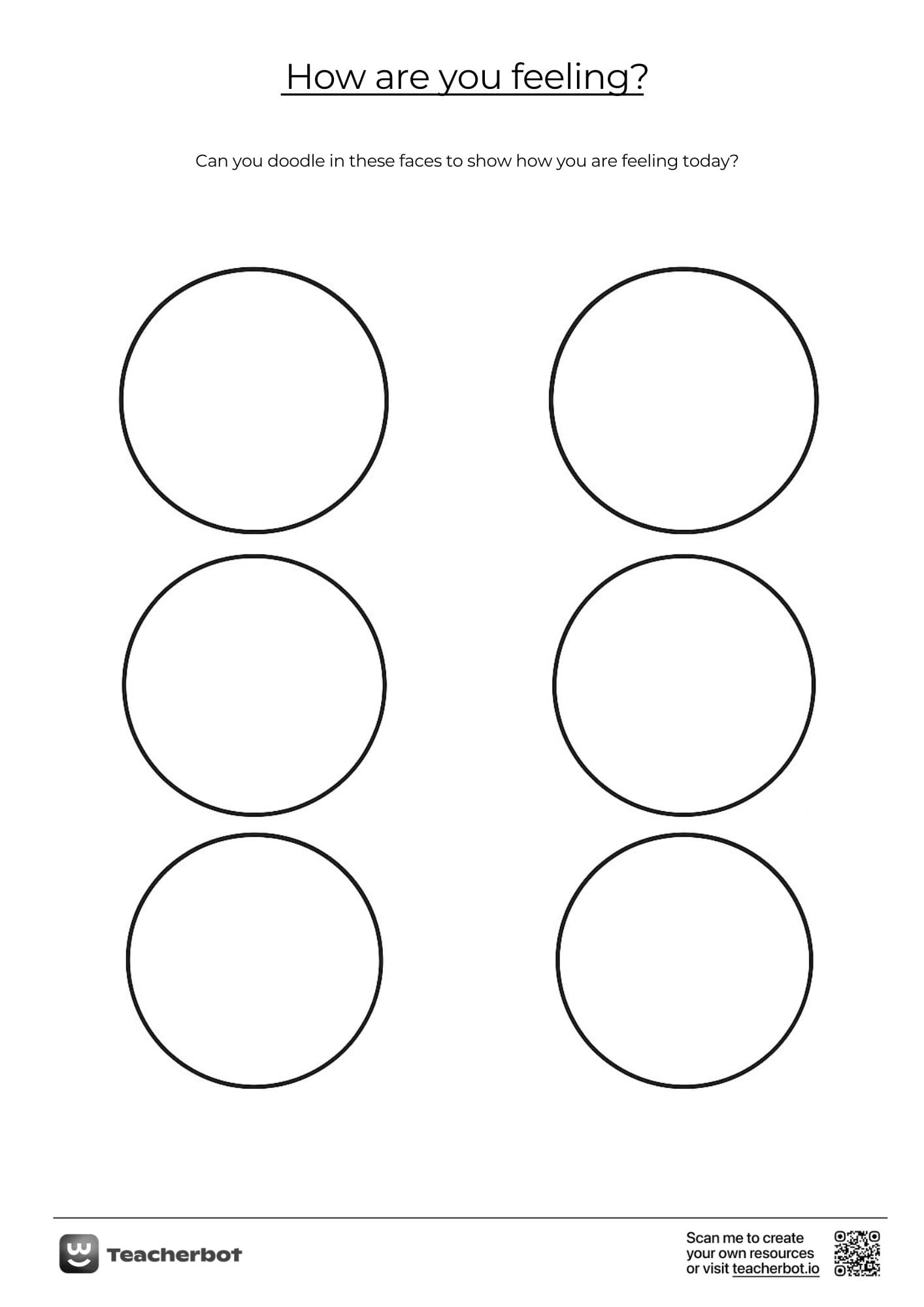
4. Seasonal or Thematic Sets: Coloring sheets based on holidays, gratitude, kindness, or growth mindset
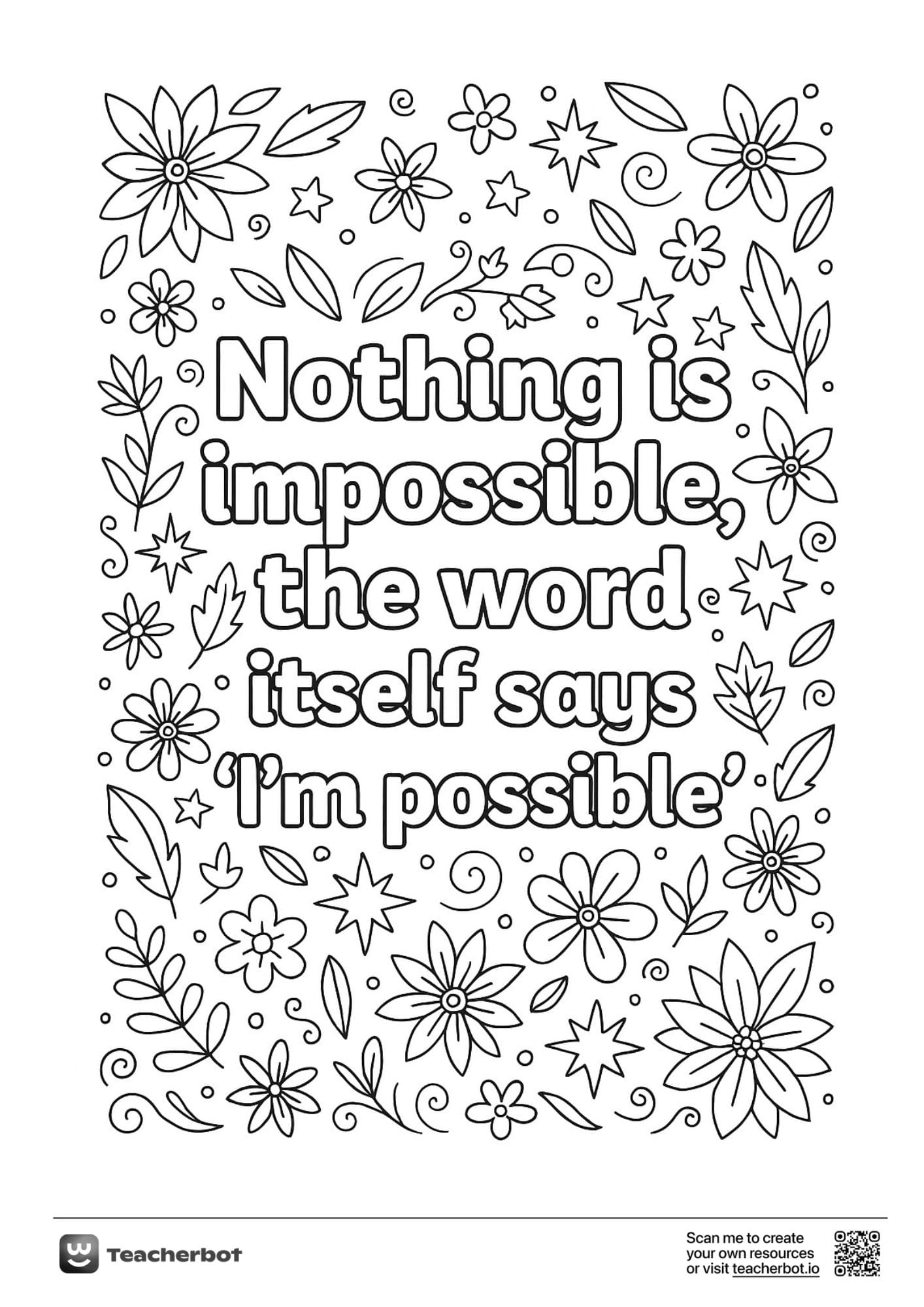
5. Breathing + Coloring Combos: Worksheets with spaces to color slowly with each breath
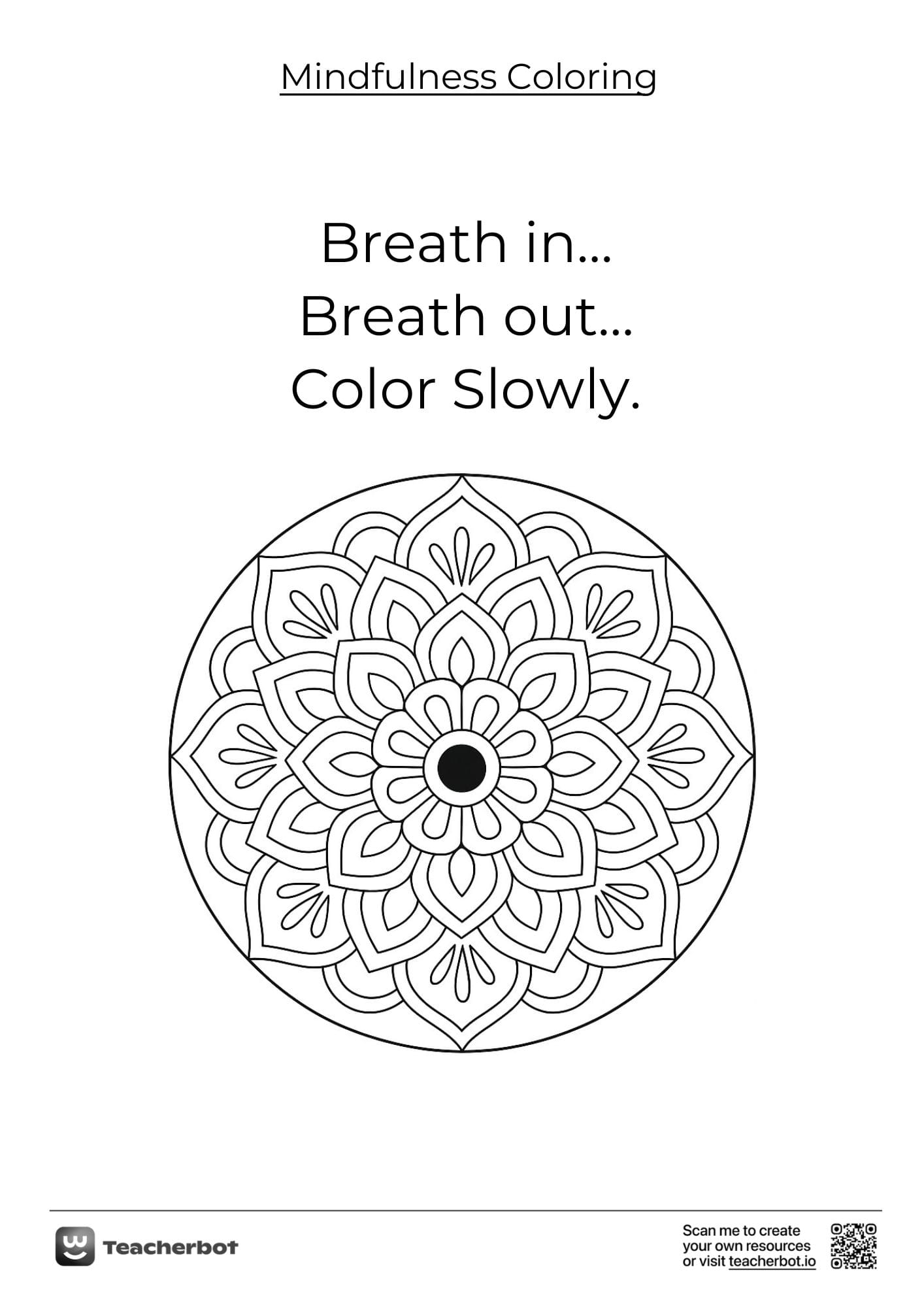
6. Gratitude Coloring Pages: Simple affirmations with accompanying visuals like hearts, stars, or flowers
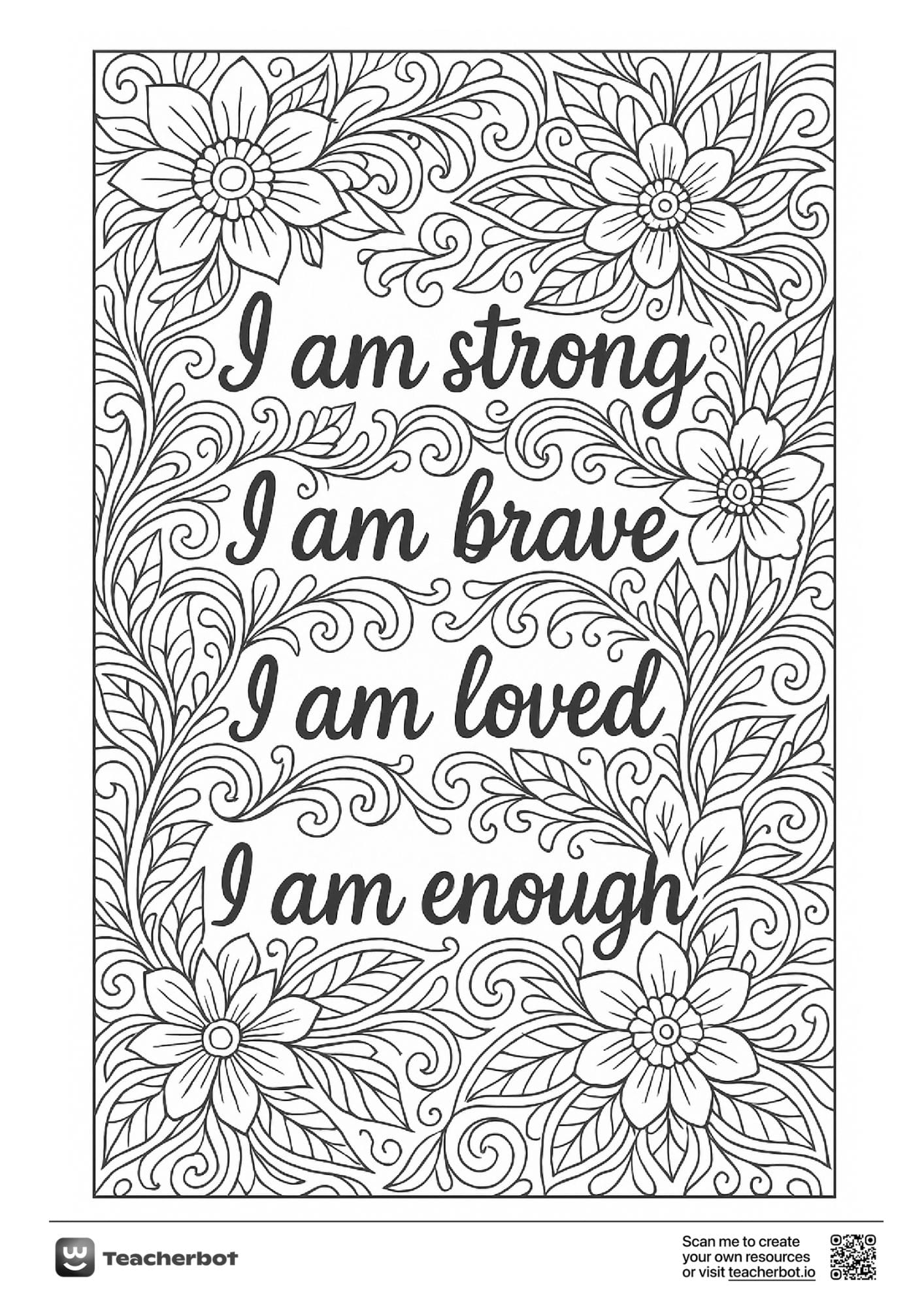
Conclusion
In today’s fast-paced and often overwhelming classroom environment, finding simple and effective ways to support students' emotional well-being is more important than ever. Mindful coloring offers a calm, creative outlet that helps students manage stress, improve focus, and develop emotional awareness; all through the simple act of coloring.




